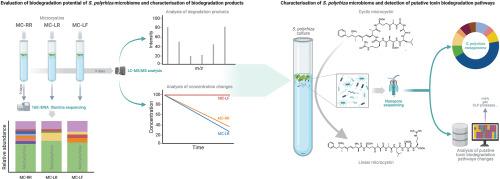浮萍Spirodela polyrhiza微生物群对微囊藻毒素的生物降解。
IF 5.4
2区 医学
Q2 MATERIALS SCIENCE, BIOMATERIALS
引用次数: 0
摘要
蓝藻产生的等位化学物质,包括具有肝毒性的微囊藻毒素(MCs),会对大型底栖生物的生长产生抑制作用。然而,人们对与大型藻类相关的细菌和藻类(大型藻类微生物群)在减轻蓝藻毒素的直接负面影响方面的作用仍知之甚少。在本文中,我们分析了大型藻类 Spirodela polyrhiza 的微生物群对微囊藻毒素-RR、MC-LR 和 MC-LF 的生物降解情况。我们观察到了两种 MC 变体的生物降解,并通过 LC-MS/MS 分析确定了 MC-RR (m/z 1011、984、969、877、862、820 和 615)和 MC-LR (m/z 968 和 653)的降解产物,其中包括 8 种以前未报道过的产物。没有检测到 MC-LF 的降解产物,这表明它在实验条件下具有稳定性和抗性。基于 NGS 的微生物群落分析表明,不同实验处理下的细菌群落组成没有重大差异。在多根瘤菌微生物群中发现了之前报道的能够降解 MC 的类群。此外,编码推测的微囊藻毒素酶同源物的基因的存在以及新线性中间体的形成表明,其生化途径与之前报道的相似,但并不完全相同。水生植物微生物群生物降解微囊藻毒素的能力具有重要的环境意义,需要在这一领域开展进一步的研究。本文章由计算机程序翻译,如有差异,请以英文原文为准。

Biodegradation of microcystins by microbiota of duckweed Spirodela polyrhiza
Cyanobacteria-produced allelochemicals, including hepatotoxic microcystins (MCs), exert an inhibitory effect on macrophyte growth. However, the role of macrophyte-associated bacteria and algae (macrophyte microbiota) in mitigating these immediate negative effects of cyanotoxins remains poorly understood. In this paper, we analyzed the biodegradation of microcystin-RR, MC-LR, and MC-LF by microbiota of the macrophyte Spirodela polyrhiza. The biodegradation of two MC variants was observed and LC-MS/MS analysis allowed identifying the degradation products of MC-RR (m/z 1011, 984, 969, 877, 862, 820, and 615) and MC-LR (m/z 968 and 953), including eight previously unreported products. No degradation products of MC-LF were detected, suggesting its stability and resistance under experimental conditions. NGS-based profiling of microbial consortia revealed no major differences in bacterial community composition across experimental treatments. Taxa previously reported as capable of MC degradation have been found in S. polyrhiza microbiota. Furthermore, the presence of genes encoding putative microcystinase homologues and the formation of new linear intermediates suggest a biochemical pathway that is similar, but not identical to previously reported. The ability of aquatic plant microbiota to biodegrade MCs holds environmental significance, and further studies in this field are required.
求助全文
通过发布文献求助,成功后即可免费获取论文全文。
去求助
来源期刊

ACS Biomaterials Science & Engineering
Materials Science-Biomaterials
CiteScore
10.30
自引率
3.40%
发文量
413
期刊介绍:
ACS Biomaterials Science & Engineering is the leading journal in the field of biomaterials, serving as an international forum for publishing cutting-edge research and innovative ideas on a broad range of topics:
Applications and Health – implantable tissues and devices, prosthesis, health risks, toxicology
Bio-interactions and Bio-compatibility – material-biology interactions, chemical/morphological/structural communication, mechanobiology, signaling and biological responses, immuno-engineering, calcification, coatings, corrosion and degradation of biomaterials and devices, biophysical regulation of cell functions
Characterization, Synthesis, and Modification – new biomaterials, bioinspired and biomimetic approaches to biomaterials, exploiting structural hierarchy and architectural control, combinatorial strategies for biomaterials discovery, genetic biomaterials design, synthetic biology, new composite systems, bionics, polymer synthesis
Controlled Release and Delivery Systems – biomaterial-based drug and gene delivery, bio-responsive delivery of regulatory molecules, pharmaceutical engineering
Healthcare Advances – clinical translation, regulatory issues, patient safety, emerging trends
Imaging and Diagnostics – imaging agents and probes, theranostics, biosensors, monitoring
Manufacturing and Technology – 3D printing, inks, organ-on-a-chip, bioreactor/perfusion systems, microdevices, BioMEMS, optics and electronics interfaces with biomaterials, systems integration
Modeling and Informatics Tools – scaling methods to guide biomaterial design, predictive algorithms for structure-function, biomechanics, integrating bioinformatics with biomaterials discovery, metabolomics in the context of biomaterials
Tissue Engineering and Regenerative Medicine – basic and applied studies, cell therapies, scaffolds, vascularization, bioartificial organs, transplantation and functionality, cellular agriculture
 求助内容:
求助内容: 应助结果提醒方式:
应助结果提醒方式:


